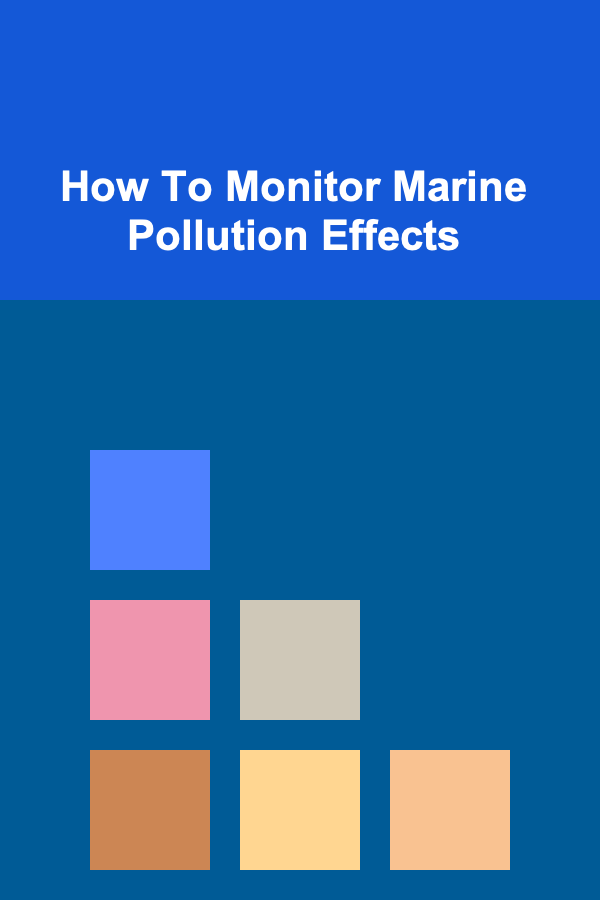
How To Monitor Marine Pollution Effects
ebook include PDF & Audio bundle (Micro Guide)
$12.99$5.99
Limited Time Offer! Order within the next:

Marine pollution is one of the most pressing environmental issues of the modern era. Oceans and seas cover about 71% of the Earth's surface and play a critical role in sustaining life, regulating the climate, and supporting biodiversity. However, the increasing impact of pollution on marine ecosystems has become a global concern. The monitoring of marine pollution is essential for understanding its effects on marine life, human health, and the overall health of the planet. In this article, we will explore the various methods and techniques used to monitor the effects of marine pollution, the challenges faced in this field, and the future of marine pollution monitoring.
Understanding Marine Pollution
Before we dive into the monitoring techniques, it's important to understand the types of marine pollution and their effects. Marine pollution refers to the introduction of harmful substances into the marine environment, leading to adverse effects on marine ecosystems. The sources of marine pollution are diverse and can be categorized into several types:
- Plastic Pollution: Plastics are one of the most pervasive pollutants in the oceans, affecting marine life in various ways. Marine animals, such as fish, sea turtles, and birds, often mistake plastic debris for food, leading to ingestion and subsequent injury or death. Additionally, plastics break down into microplastics, which are harmful to marine organisms at all levels of the food chain.
- Oil Pollution: Oil spills are another major form of marine pollution. Oil leaks from ships, offshore drilling platforms, and coastal industries can have devastating effects on marine life. The oil coats the surfaces of marine organisms, disrupts reproductive systems, and contaminates the food chain.
- Chemical Pollution: Industrial activities often release hazardous chemicals into the oceans, including heavy metals like mercury, cadmium, and lead, as well as pesticides and fertilizers. These pollutants can cause a wide range of health problems in marine organisms, including cancer, reproductive issues, and impaired growth.
- Nutrient Pollution (Eutrophication): Excessive nutrients, primarily nitrogen and phosphorus, are often released into the ocean from agricultural runoff, sewage, and industrial waste. These nutrients can cause eutrophication, where the excessive growth of algae depletes oxygen levels in the water, leading to "dead zones" where marine life cannot survive.
- Noise Pollution: Ships, submarines, and other human activities generate underwater noise that disrupts marine species, especially those that rely on sound for communication, navigation, and hunting. This form of pollution can interfere with the behavior of marine mammals like whales and dolphins.
- Thermal Pollution: The release of heated water from industrial processes, such as power plants, can raise the temperature of nearby marine environments, leading to changes in species composition, disrupted reproductive cycles, and coral bleaching.
The Impact of Marine Pollution
Marine pollution has significant and far-reaching consequences. It can disrupt entire ecosystems, leading to the loss of biodiversity and the collapse of local economies that rely on healthy marine environments. Here are some of the key effects of marine pollution:
- Loss of Biodiversity: Marine pollution threatens species diversity by causing habitat destruction, poisoning organisms, and disrupting reproductive cycles. Coral reefs, which are highly sensitive to pollution, are particularly at risk, with many species of marine life depending on them for shelter and food.
- Food Security: Marine pollution impacts fish populations, which are a vital food source for millions of people worldwide. Contaminants like heavy metals and microplastics accumulate in the tissues of marine organisms, making seafood potentially hazardous to human health.
- Economic Losses: Coastal communities that rely on fishing, tourism, and other marine industries are economically vulnerable to pollution. Declining fish stocks, beach contamination, and habitat destruction can all result in significant financial losses.
- Human Health Risks: Pollution in the ocean often finds its way into the food chain, with toxic chemicals, heavy metals, and plastics contaminating seafood. Consuming polluted seafood can have long-term health implications for humans, such as neurological disorders, cancer, and hormone disruption.
Methods of Monitoring Marine Pollution Effects
Monitoring the effects of marine pollution is a complex and multifaceted task, as it requires collecting data on various pollutants, their sources, and the ways in which they affect marine life and ecosystems. There are several techniques and tools used to assess the extent and impact of marine pollution, which are employed by scientists, environmental agencies, and policymakers to understand the scale of the problem and inform conservation efforts.
1. Remote Sensing
Remote sensing involves the use of satellite and aerial imagery to collect data about the Earth's surface. This technique is particularly useful for monitoring large-scale environmental changes, such as oil spills, algal blooms, and plastic pollution, that may be difficult to detect using traditional methods.
- Satellite Imaging: Satellites equipped with specialized sensors can capture high-resolution images of the ocean's surface, providing real-time data on the distribution of pollutants. For example, satellite sensors can detect oil slicks by measuring changes in the ocean's surface temperature, texture, and color.
- Aerial Surveys: Drones and aircraft can be used to conduct aerial surveys of coastal areas and open ocean regions, allowing for the detection of pollution sources, such as ships discharging waste or large aggregations of debris. Aerial surveys are particularly useful for monitoring plastic pollution and marine debris on beaches.
- Advantages: Remote sensing allows for the monitoring of vast areas and is particularly valuable for tracking large-scale events such as oil spills or algal blooms. It also enables continuous monitoring over long periods, providing insights into trends and changes in pollution levels.
- Limitations: Remote sensing can provide limited information about the type and concentration of pollutants. It is often more effective for detecting visible pollution (such as oil spills or surface debris) but may struggle to detect invisible pollutants, such as heavy metals or chemical contaminants.
2. Water Sampling
Water sampling is one of the most common methods used to monitor marine pollution. Samples of seawater are collected from various locations at different depths, and these samples are analyzed for pollutants such as heavy metals, pesticides, nutrients, and microplastics.
- Sampling Techniques: Water samples can be collected using various methods, including manual sampling with bottles or automated systems that collect samples at specific intervals. Samples are typically analyzed in laboratories to measure pollutant concentrations.
- Microplastics Monitoring: Water samples are filtered to isolate microplastics, which are small plastic particles that are less than 5 millimeters in size. These particles are a significant concern due to their widespread presence in the oceans and their potential to harm marine organisms.
- Advantages: Water sampling provides detailed, quantitative data on the presence and concentration of specific pollutants. It allows for a more accurate assessment of pollution levels and is essential for understanding the impact of pollutants on marine ecosystems.
- Limitations: Water sampling can be time-consuming and expensive, especially when monitoring large areas. It also only provides information for specific locations and times, meaning that continuous monitoring is challenging.
3. Biological Monitoring
Biological monitoring involves assessing the health and behavior of marine organisms to gauge the impact of pollution on ecosystems. Marine species, particularly those at higher trophic levels, accumulate pollutants in their tissues over time, making them effective indicators of environmental health.
- Bioindicators: Certain species, known as bioindicators, are sensitive to environmental changes and can be used to track pollution levels. For example, oysters, mussels, and other filter feeders accumulate toxins such as heavy metals and pesticides, making them useful for monitoring pollution.
- Bioaccumulation and Biomagnification: Monitoring the accumulation of pollutants in marine organisms (bioaccumulation) and the amplification of pollutants as they move up the food chain (biomagnification) is essential for understanding the long-term effects of marine pollution on ecosystems and human health.
- Ecotoxicology Studies: Researchers conduct ecotoxicology studies to assess the effects of pollutants on marine organisms' physiology, behavior, and reproduction. These studies provide valuable information on how pollution impacts marine species and ecosystems at various levels of biological organization.
- Advantages: Biological monitoring offers insights into the real-world impacts of pollution on marine life, helping to assess not only pollutant concentrations but also the ecological consequences of pollution. It also provides data on how pollutants affect the health and survival of marine organisms over time.
- Limitations: Biological monitoring can be complex, as different species may react to pollutants in different ways. Additionally, the interpretation of biological data may be confounded by other environmental factors, such as temperature or habitat degradation.
4. Environmental Modeling
Environmental modeling involves the use of computer simulations to predict the distribution, movement, and fate of pollutants in marine environments. Models can simulate how pollutants spread in the ocean, how they interact with marine organisms, and how long they persist in the environment.
- Hydrodynamic Models: These models simulate the movement of water masses, currents, and tides in the ocean. They are often used to predict the spread of oil spills, chemical discharges, or plastic debris in the marine environment.
- Pollutant Fate Models: These models focus on the behavior of specific pollutants in the marine environment, predicting how pollutants degrade, persist, or bioaccumulate over time. They are useful for understanding the long-term impacts of pollution on marine ecosystems.
- Advantages: Environmental models allow for the prediction of pollution levels over large areas and extended time periods. They are particularly useful for planning responses to pollution events, such as oil spills, and can help to identify areas at risk of contamination.
- Limitations: Modeling relies on accurate data inputs and assumptions, and predictions may not always reflect real-world conditions. Models also tend to focus on specific pollutants or environmental factors, which may limit their ability to capture the full complexity of marine pollution.
5. Citizen Science and Public Engagement
In recent years, citizen science has emerged as a valuable tool for monitoring marine pollution. Through citizen science programs, members of the public can participate in data collection, reporting pollution events, and monitoring marine ecosystems.
- Public Monitoring Programs: Initiatives like beach cleanups, marine debris reporting, and water quality monitoring allow the public to contribute to marine pollution monitoring efforts. These programs help raise awareness about pollution issues and engage communities in environmental conservation.
- Advantages: Citizen science programs can significantly expand monitoring efforts, especially in remote or under-studied regions. They also promote public engagement and education on marine pollution and conservation.
- Limitations: Citizen science data may be less accurate or standardized than data collected by professionals, and there may be challenges in ensuring the quality and consistency of data.
Challenges in Monitoring Marine Pollution Effects
Monitoring marine pollution is a complex task, and there are several challenges that researchers and environmental organizations face:
- Data Gaps: While many regions are monitored for pollution, there are still large gaps in data, particularly in remote or less-studied areas of the ocean. Limited access to certain regions makes it difficult to monitor pollution effectively.
- Pollutant Variability: Pollution can vary greatly in terms of type, concentration, and toxicity, making it difficult to develop standardized monitoring techniques. For example, oil spills behave differently than nutrient pollution or plastic debris, requiring different monitoring approaches.
- Budget and Resources: Monitoring marine pollution is resource-intensive, requiring sophisticated equipment, trained personnel, and ongoing funding. Many environmental organizations and government agencies face financial constraints that limit their ability to conduct comprehensive monitoring.
- Global Coordination: Marine pollution is a global issue, and pollution in one region can impact distant ecosystems. Coordinating monitoring efforts across borders and jurisdictions is challenging, requiring international cooperation and data sharing.
The Future of Marine Pollution Monitoring
The future of marine pollution monitoring looks promising, thanks to advancements in technology, international collaboration, and increased public awareness. Some emerging trends include:
- Automation and Artificial Intelligence: The use of automated systems and AI to analyze large volumes of environmental data will improve the speed and accuracy of marine pollution monitoring. Autonomous underwater vehicles (AUVs) and drones are already being used to collect data more efficiently.
- Advanced Sensors and Biosensors: New sensors that can detect pollutants at lower concentrations and provide real-time data are being developed. Biosensors, which use biological materials to detect pollutants, offer a promising solution for continuous monitoring of marine environments.
- Global Cooperation: Efforts to combat marine pollution will require increased international collaboration, with organizations working together to share data, develop global monitoring networks, and establish regulations to reduce pollution at the source.
- Public Awareness and Involvement: As public awareness of marine pollution grows, more people will become involved in monitoring efforts through citizen science programs and advocacy. This will help create a more informed and active global community dedicated to preserving the oceans.
Conclusion
Monitoring the effects of marine pollution is essential for understanding its impacts on the environment, human health, and the global economy. Through various methods such as remote sensing, water sampling, biological monitoring, environmental modeling, and citizen science, researchers and environmental agencies are working tirelessly to track and mitigate the effects of pollution. However, there are still significant challenges to overcome, including data gaps, pollutant variability, and resource limitations. The future of marine pollution monitoring looks hopeful, with advancements in technology and global cooperation offering new tools for understanding and addressing this critical issue.

How to Set Up a Matching Donation Program at Work
Read More
How to Style Your Home with Budget-Friendly Decorative Pillows
Read More
Staying Motivated During Your Job Search: Tips for Persistence
Read More
How To Learn About a Culture Before You Go
Read More
How to Overcome Limiting Beliefs
Read More
10 Tips for a Paper-Free Daily To-Do List System
Read MoreOther Products

How to Set Up a Matching Donation Program at Work
Read More
How to Style Your Home with Budget-Friendly Decorative Pillows
Read More
Staying Motivated During Your Job Search: Tips for Persistence
Read More
How To Learn About a Culture Before You Go
Read More
How to Overcome Limiting Beliefs
Read More